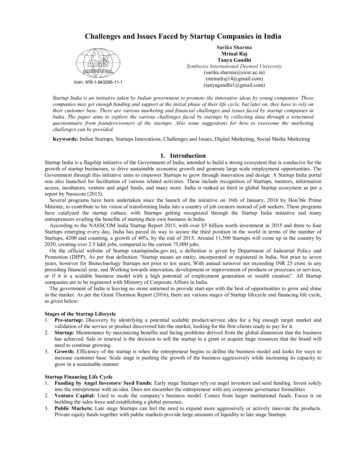
Transcription
Challenges and Issues Faced by Startup Companies in IndiaISBN: 978-1-943295-11-1Sarika SharmaMrinal RajTanya GandhiSymbiosis International Deemed gmail.com)(tanyagandhi1@gmail.com)Startup India is an initiative taken by Indian government to promote the innovative ideas by young companies. Thesecompanies may get enough funding and support at the initial phase of their life cycle, but later on, they have to rely ontheir customer base. There are various marketing and financial challenges and issues faced by startup companies inIndia. The paper aims to explore the various challenges faced by startups by collecting data through a structuredquestionnaire from founders/owners of the startups. Also some suggestions for how to overcome the marketingchallenges can be provided.Keywords: Indian Startups, Startups Innovations, Challenges and Issues, Digital Marketing, Social Media Marketing1. IntroductionStartup India is a flagship initiative of the Government of India, intended to build a strong ecosystem that is conducive for thegrowth of startup businesses, to drive sustainable economic growth and generate large scale employment opportunities. TheGovernment through this initiative aims to empower Startups to grow through innovation and design. A Startup India portalwas also launched for facilitation of various related activities. These include recognition of Startups, mentors, informationaccess, incubators, venture and angel funds, and many more. India is ranked as third in global Startup ecosystem as per areport by Nasscom (2015).Several programs have been undertaken since the launch of the initiative on 16th of January, 2016 by Hon’ble PrimeMinister, to contribute to his vision of transforming India into a country of job creators instead of job seekers. These programshave catalyzed the startup culture, with Startups getting recognized through the Startup India initiative and manyentrepreneurs availing the benefits of starting their own business in India.According to the NASSCOM India Startup Report 2015, with over 5 billion worth investment in 2015 and three to fourStartups emerging every day, India has paved its way to secure the third position in the world in terms of the number ofStartups, 4200 and counting, a growth of 40%, by the end of 2015. Around 11,500 Startups will come up in the country by2020, creating over 2.5 lakh jobs, compared to the current 75,000 jobs.On the official website of Startup (startupindia.gov.in), a definition is given by Department of Industrial Policy andPromotion (DIPP). As per that definition “Startup means an entity, incorporated or registered in India, Not prior to sevenyears, however for Biotechnology Startups not prior to ten years, With annual turnover not exceeding INR 25 crore in anypreceding financial year, and Working towards innovation, development or improvement of products or processes or services,or if it is a scalable business model with a high potential of employment generation or wealth creation”. All Startupcompanies are to be registered with Ministry of Corporate Affairs in India.The government of India is leaving no stone unturned to provide start-ups with the best of opportunities to grow and shinein the market. As per the Grant Thornton Report (2016), there are various stages of Startup lifecycle and financing life cycle,as given below:Stages of the Startup Lifecycle1. Pre-startup: Discovery by identifying a potential scalable product/service idea for a big enough target market andvalidation of the service or product discovered hits the market, looking for the first clients ready to pay for it.2. Startup: Maintenance by maximizing benefits and facing problems derived from the global dimension that the businesshas achieved. Sale or renewal is the decision to sell the startup to a giant or acquire huge resources that the brand willneed to continue growing.3. Growth: Efficiency of the startup is when the entrepreneur begins to define the business model and looks for ways toincrease customer base. Scale stage is pushing the growth of the business aggressively while increasing its capacity togrow in a sustainable mannerStartup Financing Life Cycle1. Funding by Angel Investors/ Seed Funds: Early stage Startups rely on angel investors and seed funding. Invest solelyinto the entrepreneur with an idea. Does not encumber the entrepreneur with any corporate governance formalities2. Venture Capital: Used to scale the company’s business model. Comes from larger institutional funds. Focus is onbuilding the sales force and establishing a global presence.3. Public Markets: Late stage Startups can feel the need to expand more aggressively or actively innovate the products.Private equity funds together with public markets provide large amounts of liquidity to late stage Startups.
110Sixteenth AIMS International Conference on Management1.1 The Indian Startups JourneyIndian start-up industry is on the up-swing since last few years, with multiple global investors eyeing the India start-up space;it is slated to grow larger than before. However the road to success is not as smooth as it appears to be. The larger problemsplaguing the businesses, such as the unorganized and fragmented Indian market, lack of clear and transparent policyinitiatives, lack of infrastructure, lack of knowledge and exposure.According to a report by Grant Thornton and Assocham (2016), most people think that having a domain name, setting up awebsite, moving to social media are complex, costly and time consuming. But Indian markets are largely unorganized andfragmented that create a roadblock for a startup to succeed. Consumer behavior of Indian consumer changes in every 3050km that makes it really difficult for a startup to create business or market strategy for their products or services. MostStartups generally get stuck in stagnancy and gradually shut down.There are various funding options available for Startup in early stages, but later no proper guidance or support is providedfor the marketing of their products. For their services or products, the Startups, which are usually new and small have nochoice but to rely mainly on new investors and customers. Only customers can keep the ball rolling in terms of generating thefunds required for running of the business. Therefore it’s vital to adopt marketing techniques to acquire customers for thesame. Marketing is very important to survival of these companies (Thornton &Assocham, 2016).Indian telecom industry is growing very fast, mobile connectivity has made inroads in the rural and urban population.Government of India’s digital push is going to improve connectivity and data to the next level. The race to cheapest data hasstarted and disruption is certain. The cheap data has helps everyone to get their hands on it, start-ups will have an easier timeto tap into markets, territories and even traditional businesses.Despite all these above mentioned efforts by government, still Startup companies are facing market problems and arefailing. According to Skok (2016), among the various reasons of failures of Startups the major is that, they gradually run intothe problem of their being very little market for the service or product that they created. There is not enough marketing doneto attract the potential customers and then towards actual purchase. Sometimes the market timing is wrong.2. Literature ReviewVarious studies which address the issues of Startup companies in India are considered for the review of literature. As perChokhani (2017) on the Challenges Faced by Startup Companies Skilled talent is hesitant to join start-ups, as they havewitnessed in the past mass firing and downsizing. Raising the capital has been a long drawn challenge for start-ups. In startups employment is uncertain due to companies reaching scale and then downsizing for better efficiencies, the industry issaturated with such examples. Angel investment and seed investment is easier to find, as the amounts are smaller, it hasgotten much tougher to go for later stage rounds, as companies burn too fast and do not look at unit economics. Rigoroussurvey of the literature was done for studies and research papers on Challenges and issues of Startups in India. These arepresented as below:Goel (2018) cited some Challenges and Issues, such as culture and awareness, Social issues, Technology infrastructure,Financial Issues, Sustainability Issues, Regulatory Issues.Madhvapaty& Rajesh (2018) addressed the Challenges of HR Tech Startups such as failure to lay groundwork foradoption by employees. While there are diverse products and technologies in the market, the core challenge is to findthe right product-market fit.Shukla, Chauhan & Saumya, (2018) in their study presented a formally structured representation of the issues facedby female entrepreneurs in a manner which is mutually exclusive and collectively exhaustive. In the context ofemerging economies in fast-developing nations such as India. Singh (2018) identified the Challenges for Indian Startupsas, Sustain growth, be profitable, create real businesses. Kamaldeep (2017) presented some Startup business challenges andopportunities for Startups. In India, the opportunities for the start-ups are immense, but so are the challenges. Chokhani(2017) stated that, it will take combined efforts from the government and the start-ups to overcome these challengesSunanda (2017) argued about managing the Startups to avoid failures through case study on zomato and redbus. Thoroton(2016) explained the challenges like Culture and Awareness, Social, Technology infrastructure, Financial, Sustainability,Regulatory Issues, Multi window clearances. Jain (2016) stated Problems in Indian markets are that they are unorganized andfragmented. There is a lack of unambiguous and transparent policy motives, lack of communications sources, lack ofknowledge and exposure.Sarangi (2015) provided Reasons of why do most Indian Startups fail? To make Indian Startups actually work, it isnecessary to add more constraints to the money supply. An unbridled supply of money is not exactly the best way to goforward.Ravi (2015) explained that a combination of increasing population, growing internet usage and mobile penetration, growingeconomy, being a major mobile market and exponentially increasing online retailing set the stage for India to be one of thebiggest Startup destinations.Sharifi & Hossain (2015) stated the various financial challenges faced by the Startups in India. Also depicts the difficultiesfaced by the Startups at the initial stage. The major findings are major leap in technology have led investors to raise the barKeeping in mind the importance of the subject and the research gaps therein, we have undertaken this study with the main aimto address the important issue of understanding the challenges and issues faced by Startup companies in India.
Sixteenth AIMS International Conference on Management1113. Research Methodology and DesignUniverse of the StudyThe Startups in India which are registered with ministry of corporate affairs and are operational in India are considered for thestudy. Founders/ Owners of the Startups form the universe of the study.Sampling FrameThe list of Startups was taken from the official website (startupindia.gov.in) which served as the sampling frame for thepurpose of the study.Sampling Technique and Sample SizeConvenience sampling method was used for collecting the data. Total number of respondents representing the startups was57.Tools and Techniques of Data CollectionThe study is based on primary data. To collect the data from respondents a self-designed pre-tested questionnaire andpersonal interview method was used, to meet the objectives of the study.4. Data Analysis and InterpretationData Analysis was done by using MS-Excel. The coded questionnaire was entered in excel and analysis was carried out.Challenges faced by the Startups are categorized as marketing, finance, and other challenges. It is then presented in the Tablesand Figures below.It can be seen from Table 1 and Figure 1 that major marketing challenges which are faced by startups are competition fromthe local vendors, branding of the company, and unorganized and fragmented markets. There are other challenges also whichare as, failure to lay groundwork, very little market for the service or product that they created, finding marketingprofessionals, to find the right product-market fit, keeping up with latest trends and technology.Table 1 Marketing ChallengesVariableNumber of ResponsesCompetition from local vendors45Branding of the company34Unorganized and fragmented markets28Create real businesses20Maintaining CRM10Unique ideas to attract customers22Choosing right social media platform18Other48Total225Competition from localvendorsBranding of the company20%21%15%8%Unorganized andfragmented marketsCreate real businessesMaintaining CRM10%4%9%13%Unique ideas to attractcustomersChoosing right social mediaplatformFigure 1 Marketing Challenges faced by StartupsIt can be seen from Table 2 and Figure 2 that major Finance related challenges which are faced by startups are tougher toget finance and working capital for later stage and be profitable, payment related problems, not choosing the right fundoption, and ensuring quality of product while keeping it low cost.
112Sixteenth AIMS International Conference on ManagementTable 2 Financial ChallengesVariableNumber of RespondentsRaising the capital12Ensuring quality of product while keeping it low cost23Tougher to get finance and working capital for later stage and Be profitable45Budget allocation9Pricing of the services8Not choosing the right fund option22Payment related problems39Total1588%25%14%Raising the capitalEnsuring quality of product while keeping it lowcostTougher to get finance and working capital forlater stage and Be profitableBudget allocation14%28%Pricing of the services5%6%It can be seen from Table 3 and Figure 3 that there are other related challenges which are faced by startups. These areTable 3 Other ChallengesVariablesNumber of RespondentsLack of communications sources3Major leap in technology11Technology infrastructure32Regulatory Issues13Lack of knowledge and exposure8Skilled talent is hesitant to join start-ups23Culture and awareness6Social issues9Total6%9%3%10510%22%30%8%Lack of communications sourcesMajor leap in technologyTechnology infrastructureRegulatory IssuesLack of knowledge and exposureSkilled talent is hesitant to join start-upsCulture and awarenessSocial issues12%5. Results and DiscussionsFrom the above section it can be seen that although government has taken many initiative and is providing facilities to thestartups, still there is a long way to go. Startups are facing various issues and challenges in terms of marketing, finance,
Sixteenth AIMS International Conference on Management113technological and other related matter. There is a need to address these challenges so as to move forward in the startupjourney and to motivate entrepreneurs.6. Limitations of the Study and Future ScopeThe study was carried out for 57 startup companies operating in the various sectors. The sample size is less therefore thestudy should be carried out for a higher sample size. Presently it can be considered as a base for the further research. Thesector perspective was not considered and it was carried out for all the sectors. To address the sector specific issues the studyshould be carried out for the particular sector such as Education, Automotive, or Agri Tech. It will help in reachingmeaningful inferences and resolving the challenges of the specific sectors.7. i, R. (2017), Challenges and opportunities for Indian start-ups; Key points to note, retrieved points-to-note/524728/Goel, S. (2018).Startups in India- Retrospect and Prospects, International Journal of Research, 5(7), 2676-2685.Jain, S.(2016), Growth of startup ecosystems in India, International Journal of Applied Research, 2(12), 152-154.Kamaldeep, k. (2017), Startup India: challenges & opportunities, Journal of social science research, 11(1), 2318-2321.Madhvapaty, M. & Rajesh, A. (2018), HR tech startups in India, Human Resource Management International Digest,26(3), 11-13.Mittal, A. (2014), Indian Startups: Challenges and Opportunities, Economic Times, retrieved w/45272839.cms?utm source contentofinterest&utm medium text&utm campaign cppst accessed on 12.10.2017.Nasscom (2015). NASSCOM (2015), Start-up India - Momentous Rise of the Indian Start-up Ecosystem, retrieved ia/2016 /Presentations/10K-NIPP%20Intro %20SDC.pdf accessed www.cse.iitd.ernet.in/ srsarangi/startups.html.Sharifi, O. & Hossain, B.K. (2015), Understanding the financing challenges faced by startups in India, InternationalJournal of Science Technology and Management, 4(1), 264-272.Singh, S. (2018, May 18), Challenges for Indian startups: Sustain growth, be profitable, create real businesses, retrievedfrom icleshow/64199449.cms.Skok, D. (2016), Why Startups Fail? retrieved from / .Sunanda, K. (2017), How to Start and Manage Startup Companies in India, International Journal of EngineeringDevelopment and Research, 5(4), 167-17.Thornton, G. and Assocham (2016), Startups India-An Overview, retrieved from http://www.grantthornton.in /globalassets/1.-member-firms/ India / assets / pdfs /, grant thornton-startups report.pdf.
The paper aims to explore the various challenges faced by startups by collecting data through a structured questionnaire from founders/owners of the startups. . entrepreneurs availing the benefits of starting their own business in India. According to the NASSCOM India Startup Report 2015, with over 5 billion worth investment in 2015 and .










